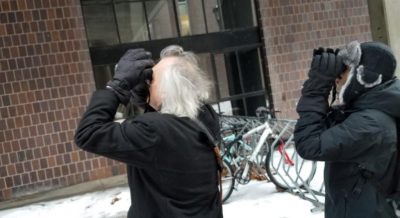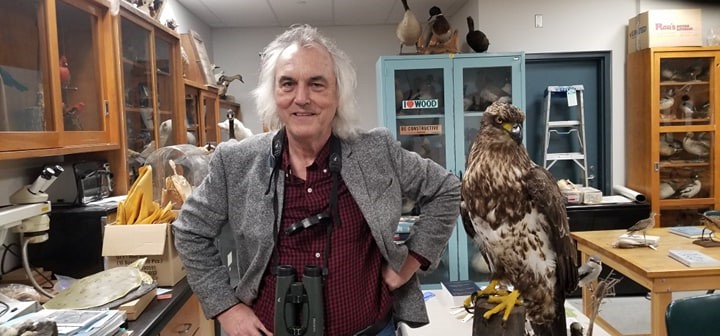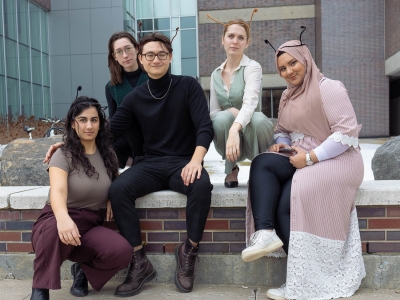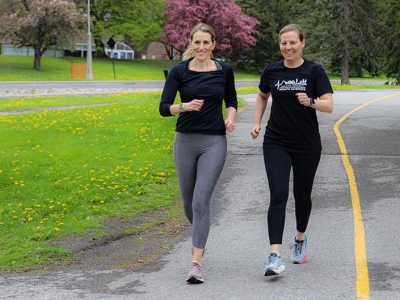Go Birding with Michael Runtz
During the Winter 2019 term, birding tours will occur weekly and begin at 7:30 a.m. on Tuesdays. The meeting point is the entrance of Nesbitt Building, near the bird feeders. No advance notice required; everyone from the Carleton community is welcome!
Birding with Biology’s Michael Runtz
by Greg Guevara, Fourth-year Journalism student, Carleton University
Michael Runtz treks shin-deep through a puddle of water, the snow around him melting from the abnormally warm February temperature. A group of students follow him, tip-toeing where they can around the massive puddles.

Runtz is leading his weekly Tuesday morning birdwatch. The warmer weather means birdwatching today is going to be a little more difficult, but it’s also a bad sign of a changing climate—a bad sign for the birds.
Runtz is staring through his binoculars at a flock of birds perched on top of Canal Building.
“When it’s really cold, they’ll bask in the sun,” he says, gesturing to the birds. Despite it being early February, it’s warm enough to keep your gloves off. “No need for basking today.”
He continues on the path, smiling at a passing student. They have a brief conversation and she continues on her way.
Once she’s out of earshot, he turns to his following.
“What’s her name,” he mulls. “I can’t remember, isn’t that terrible?”
He sets off back down the path. “I’m better with birds than I am with people.”
Runtz and the birdwatchers yell out the kinds of birds they spot and point at them. Then, everyone turns in the direction of the point.
Later, Runtz is explaining how one kind of bird just spotted had been introduced by humans to Canada over a hundred years ago, and then someone yells “a duck!” Everyone stops what they’re doing and twirls around to spot it or take a picture. “Good catch!” says Runtz.
Near the end of the walk he points, with a similar kind of enthusiasm, to a distant student walking in shorts and t-shirt. “Now it’s warm, but it’s not warm enough to do that. His arms look pink!”
And then the tour is over. The trip was a success, managing to spot fourteen different kinds of birds in just a little under an hour.
Runtz has been birdwatching since he was five, and the last decade has brought with it a host of changes.
“Equipment’s gotten better, guidebooks have gotten better… with the internet and emails and texting, information is instantaneous,” Runtz says on the way up to his office.
“And also, in terms of the birds themselves, I’ve seen changes in distribution and numbers and so on. Some have gone up,” he says, “and many have gone down in numbers. Birds that were common when I was young. Now, some are endangered even.”
When asked how he stays optimistic, Runtz says “Who says I’m optimistic?”
“I’m really afraid of what lies in the future. Especially when the political climate has changed, and you see more and more people like Donald Trump and Doug Ford who have no concern for the environment… it doesn’t bode well for the future of birds at all.”

Runtz’s CUOL Natural History course has been massively successful. BIOL 1902 V recently broke 50 000 students to have taken the course since he created it over thirty years ago.
“What I’m really pleased about is that I created that course from nothing, and it’s giving students a look at biology that they don’t get usually.”
In a subtle way, Runtz hopes that he inspires the people he teaches to better tend for the planet.
“My simple goal is to educate people, and get people exposed to nature. I think the best solution to create an atmosphere desirable to preserve things is to have people make contact with the organisms we want to protect.”
Runtz’s new photography book Algonquin Wild: A Naturalist’s Journey through the Seasons features the only printed picture of a snow flea in action and will be available for purchase in April.
This article was originally featured by CUOL.
Wednesday, March 20, 2019 in General
Share: Twitter, Facebook



